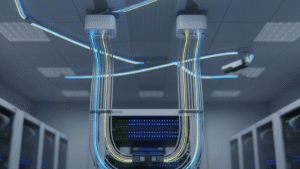Digital imaging systems are only as good as the power behind them. If your power source is unstable, even the most advanced imaging device can’t perform properly.
A digital imaging system needs a reliable switching power supply to ensure stable voltage, protect sensitive electronic components, and maintain image quality without interruptions or degradation.
Poor power equals poor performance. In digital imaging equipment, from diagnostic imaging in hospitals to industrial inspection systems, voltage fluctuations, noise, or ripple from the power supply can directly affect output quality. To avoid downtime, damaged parts, or inaccurate results, using a properly designed switching power supply is not just a choice—it’s a must.
What Makes Digital Imaging Systems Sensitive to Power Issues?
Power noise causes digital image distortion. Voltage fluctuations lead to unstable performance.
Digital imaging systems rely on precise voltages for stable sensor operation, signal processing, and image rendering. Any ripple, spike, or noise in the power line can affect image accuracy or device stability.
How Sensitive Are Digital Imaging Systems to Ripple and Noise?
Let me explain this by breaking it down into the different parts of an imaging system:
| Component | Function | Impact of Poor Power |
|---|---|---|
| Image Sensor | Captures visual data | Voltage noise can blur or distort raw image signals |
| Image Processor | Shows an image to the user | Requires consistent voltage for timing and processing accuracy |
| Display Interface | Shows an image to the user | Sudden power drops cause flicker or display failure |
| Communication Module | Sends image data to storage or cloud | Ripple causes communication errors or slowdowns |
In high-resolution systems like digital X-rays or 4K inspection cameras, even minor inconsistencies in voltage can throw off image accuracy. I’ve seen systems fail to calibrate properly just because the wrong power adapter was used.

How Do I Choose the Right Power Adapter for My Imaging Product?
Choosing the wrong adapter damages components. But the right one extends product life.
Choose a switching power adapter with low ripple (under 100mVp-p), high efficiency (DOE VI or above), EMI shielding, and the correct voltage/current for your imaging device. Custom solutions are often best for system integration.
What Features Matter Most for Imaging Power Supplies?
When I work with clients building medical or industrial imaging systems, we often focus on a few core specs. Here’s a checklist I use:
- Voltage Accuracy: Needs to stay within ±5% for sensors to function consistently.
- Ripple and Noise: Should be less than 100mVp-p for clean image data.
- EMI Suppression: Shielding and filtering are required to prevent interference.
- Safety Standards: Must meet medical (IEC 60601) or industrial (EN/UL) certifications.
- Isolation Protection: 2 MOPP or reinforced insulation for safety-critical applications.
For example, we had a customer in the dental imaging space using a 24V 2.5A system. Their original adapter had poor filtering. Once we replaced it with our medical-grade UES60L1-SPAC series, the image noise disappeared.
Does Power Adapter Wattage Affect Imaging System Performance?
Underpowered systems freeze. Overpowered ones overheat.
Matching the wattage to your imaging system ensures it runs efficiently and safely. Too low causes brownouts; too high may overheat or damage the device over time.
How Do Different Wattages Affect Usage?
Let’s look at a few imaging applications:
| Device | Typical Voltage | Current | Suggested Wattage |
|---|---|---|---|
| Portable Ultrasound | 12V | 3A | 36W |
| Dental Scanner | 24V | 2.5A | 60W |
| Endoscopic Camera | 5V | 4A | 20W |
| Industrial Inspection Camera | 56V | 0.6A | 35W |
A mismatch in power can cause shutdowns, overcurrent protection triggers, or overheating. One imaging client had to swap power supplies multiple times during tests because the unit kept stalling under load. A proper wattage match solved the problem immediately.
Why Are Custom Power Solutions Better for Imaging Systems?
Off-the-shelf isn’t always enough. Custom is smarter and safer.
Custom power supplies let you optimize size, connector type, EMI performance, and safety features for your exact imaging device and market requirements.
What Can Be Customized in a Power Adapter?
From experience, most imaging companies benefit from at least one of the following customizations:
- Connector Type: Barrel plug, snap-in, DIN—tailored to enclosure design
- Cable Length: Reduces clutter or matches integration needs
- Output Tuning: Fine-tuned voltage or current to match non-standard loads
- Housing Material: Flame-retardant, waterproof, or antimicrobial casings
- Labeling & Branding: For internal tracking or white-labeling
Recently, one partner building portable retinal scanners needed a low-leakage, compact power adapter with special strain relief. Our custom solution helped them pass both UL and CE certifications in one round.
Conclusion
A reliable switching power supply is the backbone of a high-performance digital imaging system. Choosing the right one avoids noise, damage, or downtime.




